
© 3M 2018
ANSI Z359.18
Type A
OSHA 1926.502
OSHA 1910.140
FORM NO: 5908293 REV: A
USER INSTRUCTION MANUAL
SLIDING BEAM ANCHOR
Anchorage Connector
1
A BC
2104710
19.25in x 2.1in x 3.9in
(6.35cm x 10.16cm x 50.8cm)
3.35 lbs
(1.52 kg)
3.5 in - 14 in
(7.62 cm - 35.56 cm)
≤ 1.25 in
(≤ 3.18 cm)
≤ 0.56 in
(≤ 1.42 cm)
2104715
37.25in x 2.25in x 5.5in
(6.35cm x 10.16cm x 66.04cm)
7.26 lbs
(3.29kg)
12 in - 30 in
(30.48 cm - 76.20 cm)
≤ 2.5 in
(≤ 5.72 cm)
≤ 0.56 in
(≤ 1.42 cm)
A
B
C
Page is loading ...
Page is loading ...
Page is loading ...

FORM NO: 5908299 REV: A
5
SAFETY INFORMATION
Please read, understand, and follow all safety information contained in these instructions prior to the use of this Anchorage Connector.
FAILURE TO DO SO COULD RESULT IN SERIOUS INJURY OR DEATH.
These instructions must be provided to the user of this equipment. Retain these instructions for future reference.
Intended Use:
This Anchorage Connector is intended for use as part of a complete personal fall protection system.
Use in any other application including, but not limited to, material handling, recreational or sports related activities, or other activities not described in
the User Instructions, is not approved by 3M and could result in serious injury or death.
This device is only to be used by trained users in workplace applications.
! WARNING
This Anchorage Connector is part of a personal fall protection system. It is expected that all users be fully trained in the safe installation and operation
of their personal fall protection system. Misuse of this device could result in serious injury or death. For proper selection, operation, installation,
maintenance, and service, refer to these User Instructions and all manufacturer recommendations, see your supervisor, or contact 3M Technical Service.
• To reduce the risks associated with working with an Anchorage Connector which, if not avoided, could result in serious injury or
death:
- Inspect the device before each use, at least annually, and after any fall event. Inspect in accordance with the User Instructions.
- If inspection reveals an unsafe or defective condition, remove the device from service and repair or replace according to the User Instructions.
- Any device that has been subject to fall arrest or impact force must be immediately removed from service and destroyed.
- The device must only be installed in the specifi ed substrates or on structures detailed in the User Instructions. Installations and use outside the
scope of this instruction must be approved by 3M Fall Protection.
- The substrate or structure to which the anchorage connector is attached must be able to sustain the static loads specifi ed for the anchor in the
orientations permitted in the User Instructions.
- Only connect other fall protection subsystems to the designated anchorage connection point on the device.
- Prior to drilling or fastening, ensure no electric lines, gas lines, or other critical embedded systems will be contacted by the drill or the device.
- Ensure that fall protection systems/subsystems assembled from components made by different manufacturers are compatible and meet the
requirements of applicable standards, including the ANSI Z359 or other applicable fall protection codes, standards, or requirements. Always
consult a Competent or Qualifi ed Person before using these systems.
• To reduce the risks associated with working at height which, if not avoided, could result in serious injury or death:
- Ensure your health and physical condition allow you to safely withstand all of the forces associated with working at height. Consult with your
doctor if you have any questions regarding your ability to use this equipment.
- Never exceed allowable capacity of your fall protection equipment.
- Never exceed maximum free fall distance of your fall protection equipment.
- Do not use any fall protection equipment that fails pre-use or other scheduled inspections, or if you have concerns about the use or suitability
of the equipment for your application. Contact 3M Technical Services with any questions.
- Some subsystem and component combinations may interfere with the operation of this equipment. Only use compatible connections. Consult
3M prior to using this equipment in combination with components or subsystems other than those described in the User Instructions.
- Use extra precautions when working around moving machinery (e.g. top drive of oil rigs) electrical hazards, extreme temperatures, chemical
hazards, explosive or toxic gases, sharp edges, or below overhead materials that could fall onto you or your fall protection equipment.
- Use Arc Flash or Hot Works devices when working in high heat environments.
- Avoid surfaces and objects that can damage the user or equipment.
- Ensure there is adequate fall clearance when working at height.
- Never modify or alter your fall protection equipment. Only 3M or parties authorized in writing by 3M may make repairs to the equipment.
- Prior to use of fall protection equipment, ensure a rescue plan is in place which allows for prompt rescue if a fall incident occurs.
- If a fall incident occurs, immediately seek medical attention for the worker who has fallen.
- Do not use a body belt for fall arrest applications. Use only a Full Body Harness.
- Minimize swing falls by working as directly below the anchorage point as possible.
- If training with this device, a secondary fall protection system must be utilized in a manner that does not expose the trainee to an unintended
fall hazard.
- Always wear appropriate personal protective equipment when installing, using, or inspecting the device/system.
EN

6
Prior to installation and use of this equipment, record the product identifi cation information from the ID label in the
Inspection and Maintenance Log (Table 2) at the back of this manual.
PRODUCT DESCRIPTION:
Figure 1 Illustrates the 3M™ DBI-SALA™ Sliding Beam Anchor. The Sliding Beam Anchor is a single point anchorage connector
for a personal fall arrest system or personal fall restraint system designed to be attached to a beam.
Figure 2 Illustrates components of the Sliding Beam Anchor. See Table 1 for Component Specifi cations. The Sliding Beam Anchor
is comprised of a notched Support Bar (A) with a swiveling Connector Ring (B) and adjustable Hook Ends (C) that hook over
each edge of a beam fl ange with Tab Locks (D) that engage the notches on the Support Bar. The Sliding Beam Anchor slides
smoothly along the beam on Wear Pads (E). A Lanyard or Self-Retracting Device (SRD) is connected between the Swiveling
Connector Ring on the Sliding Beam Anchor and the appropriate attachment element on the user’s Full Body Harness.
Table 1 – Specifi cations
System Specifi cations:
Capacity: 1 Person with a combined weight (clothing, tools, etc.) of no more than:
310 lbs (141 kg) for ANSI, 420 lbs (191 kg) for OSHA.
Anchorage
Strength:
The required Anchorage Strength depends on the application:
Fall Arrest: The structure to which the Anchorage Connector is attached must sustain static loads
applied in the directions permitted by the Fall Arrest System (Figure 1) of at least: 3,600 lbs (16 kN)
with certifi cation of a Qualifi ed Person
2
; or 5,000 lbs (22 kN) without certifi cation. When more than one
Personal Fall Arrest System (PFAS) is attached to an anchorage, these static loads must be multiplied by
the number of PFAS attached to the anchorage.
OSHA 1926.500 and OSHA 1910.66: Anchorages used for attachment to a Personal Fall Arrest
System (PFAS) must be independent of any anchorage used to suspend or support platforms and
must support 5,000 lbs (22 kN) per user attached, or be designed, installed, and used as part of a
completer PFAS which maintains a Safety Factor of a least 2 and is supervised by a Qualifi ed Person
1
.
Restraint: The structure to which the Anchorage Connector is attached must sustain static loads applied
in the directions permitted by the Restraint System (Figure 1) of at least 3,000 lbs (13 kN). When more
than one Restraint System is attached to an anchorage, the static load must be multiplied by the number
of Restraint Systems attached to the anchorage.
Service
Temperature
-40°F (-40°C)
Minimum Service Temperature
Breaking
Strength
5,000 lbs (22 kN)
Minimum Breaking Strength
Dimensions: See Figure 1 for the dimensions of each Sliding Beam Anchor model.
Weight: See Figure 1 for the weight of each Sliding Beam Anchor model.
Component Specifi cations:
Figure 2
Reference Component Materials
A Support bar Aluminum Alloy
B Connector Ring Alloy Steel
C Hook Ends Aluminum Alloy
D Tab Locks Alloy Steel
E Wear Pads Nylon
1
1 Qualifi ed Person: An individual with a recognized degree or professional certifi cate, and extensive experience in Fall Protection. This individual must be capable
of design, analysis, evaluation, and specifi cation in Fall Protection.

7
1.0 PRODUCT APPLICATION
1.1 PURPOSE: Anchorage Connectors are designed to provide anchorage connection points for Fall Arrest
1
or Fall Restraint
2
systems: Restraint, Work Positioning, Personnel Riding, Rescue, etc.
Fall Protection Only: This Anchorage Connector is for connection of Fall Protection Equipment. Do not connect
Lifting Equipment to this Anchorage Connector.
1.2 STANDARDS: Your Anchorage Connector conforms to the national or regional standard(s) identifi ed on the front cover
of these instructions. If this product is resold outside the original country of destination, the re-seller must provide these
instructions in the language of the country in which the product will be used.
ANSI/ASSE Z359.7 COMPLIANT: This Anchorage Connector has been tested for compliance with the
requirements of ANSI/ASSE Z359.7. Testing covers only the the Anchorage Connector and does not extend to the
anchorage and substrate to which the Anchorage Connector is attached.
1.3 SUPERVISION: Use of this equipment must be supervised by a Competent Person
3
.
1.4 TRAINING: This equipment must be installed and used by persons trained in its correct application. This manual is to
be used as part of an employee training program as required by ANSI and OSHA. It is the responsibility of the users and
installers of this equipment to ensure they are familiar with these instructions, trained in the correct care and use of this
equipment, and are aware of the operating characteristics, application limitations, and consequences of improper use of
this equipment.
1.5 RESCUE PLAN: When using this equipment and connecting subsystem(s), the employer must have a rescue plan and
the means at hand to implement and communicate that plan to users, authorized persons
4
, and rescuers
5
. A trained, on-
site rescue team is recommended. Team members should be provided with the equipment and techniques to perform a
successful rescue. Training should be provided on a periodic basis to ensure rescuer profi ciency.
1.6 INSPECTION FREQUENCY:
The Anchorage Connector shall be inspected by the user before each use and, additionally,
by a competent person other than the user at intervals of no longer than one year.
6
Inspection procedures are described in
the “Inspection and Maintenance Log”. Results of each Competent Person inspection should be recorded on copies of the
“Inspection and Maintenance Log”.
1.7 AFTER A FALL: If the Anchorage Connector is subjected to the forces of arresting a fall, it must be removed from service
immediately, clearly marked “DO NOT USE”, and then destroyed.
2.0 SYSTEM REQUIREMENTS
2.1 ANCHORAGE: Anchorage structure requirements vary with the fall protection application. Structure on which the
Anchorage Connector is placed or mounted must meet the Anchorage Strength specifi cations defi ned in Table 1.
2.2 PERSONAL FALL ARREST SYSTEM: Figure 1 illustrates the application of this Anchorage Connector. Personal Fall Arrest
Systems (PFAS) used with the system must meet applicable Fall Protection standards, codes, and requirements. The PFAS
must incorporate a Full Body Harness and limit Arresting Force to the following values:
Maximum Arresting Force Free Fall
PFAS with Shock Absorbing Lanyard 1,800 lb (8 kN)
Refer to the instruction(s) included with your
Lanyard or SRD for Free Fall limitations.
PFAS with Self Retracting Device (SRD) 1,800 lb (8 kN)
2.3 FALL PATH AND SRD LOCKING SPEED: A clear path is required to assure positive locking of an SRD. Situations which
do not allow for an unobstructed fall path should be avoided. Working in confined or cramped spaces may not allow the
body to reach sufficient speed to cause the SRD to lock if a fall occurs. Working on slowly shifting material, such as sand
or grain, may not allow enough speed buildup to cause the SRD to lock.
2.4 HAZARDS: Use of this equipment in areas with environmental hazards may require additional precautions to prevent
injury to the user or damage to the equipment. Hazards may include, but are not limited to: heat, chemicals, corrosive
environments, high voltage power lines, explosive or toxic gases, moving machinery, sharp edges, or overhead materials
that may fall and contact the user or Personal Fall Arrest System.
2.5 FALL CLEARANCE: Figure 3 illustrates the components of a Fall Arrest. There must be suffi cient Fall Clearance (FC)
to arrest a fall before the user strikes the ground or other obstruction. Clearance is affected by a number of factors
including: (A) Anchorage Location, (B) Lanyard Length, (C) Lanyard Deceleration Distance or SRD Maximum Arrest
Distance, (D) Harness Stretch and D-Ring/Connector Length and Settling. Refer to the instructions included with your Fall
Arrest subsystem for specifi cs regarding Fall Clearance calculation.
1 Fall Arrest System: A collection of Fall Protection Equipment confi gured to arrest a free fall.
2 Fall Restraint System: A collection of Fall Protection Equipment confi gured to prevent the person’s center of gravity from reaching a fall hazard.
3 Competent Person: One who is capable of identifying existing and predictable hazards in the surroundings or working conditions which are unsanitary,
hazardous, or dangerous to employees, and who has authorization to take prompt corrective measures to eliminate them.
4 Authorized Person: For purposes of the Z359 standards, a person assigned by the employer to perform duties at a location where the person will be exposed
to a fall hazard.
5 Rescuer: Person or persons other than the rescue subject acting to perform an assisted rescue by operation of a rescue system.
6 Inspection Frequency: Extreme working conditions (harsh environments, prolonged use, etc.) may require increasing the frequency of competent person
inspections.

8
2.6 SWING FALLS: Swing Falls occur when the anchorage point is not directly above the point where a fall occurs (see Figure
4). The force of striking an object in a swing fall may cause serious injury or death. Minimize swing falls by working as directly
below the anchorage point as possible. Do not permit a swing fall if injury could occur. Swing falls will signifi cantly increase the
clearance required when a Self-Retracting Device or other variable length connecting subsystem is used.
2.7 COMPONENT COMPATIBILITY: 3M equipment is designed for use with 3M approved components and subsystems
only. Substitutions or replacements made with non-approved components or subsystems may jeopardize compatibility of
equipment and may effect the safety and reliability of the complete system.
2.8 CONNECTOR COMPATIBILITY: Connectors are considered to be compatible with connecting elements when they
have been designed to work together in such a way that their sizes and shapes do not cause their gate mechanisms to
inadvertently open regardless of how they become oriented. Contact 3M if you have any questions about compatibility.
Connectors (hooks, carabiners, and D-rings) must be capable of supporting at least 5,000 lbs. (22.2 kN). Connectors
must be compatible with the anchorage or other system components. Do not use equipment that is not compatible.
Non-compatible connectors may unintentionally disengage (see Figure 5). Connectors must be compatible in size, shape,
and strength. If the connecting element to which a snap hook or carabiner attaches is undersized or irregular in shape, a
situation could occur where the connecting element applies a force to the gate of the snap hook or carabiner (A). This force
may cause the gate to open (B), allowing the snap hook or carabiner to disengage from the connecting point (C).
Self-locking snap hooks and carabiners are required by ANSI Z359 and OSHA.
2.9 MAKING CONNECTIONS: Snap hooks and carabiners used with this equipment must be self-locking. Ensure all
connections are compatible in size, shape and strength. Do not use equipment that is not compatible. Ensure all
connectors are fully closed and locked.
3M connectors (snap hooks and carabiners) are designed to be used only as specifi ed in each product’s user’s instructions.
See Figure 6 for examples of inappropriate connections. Do not connect snap hooks and carabiners:
A. To a D-ring to which another connector is attached.
B. In a manner that would result in a load on the gate. Large throat snap hooks should not be connected to standard
size D-rings or similar objects which will result in a load on the gate if the hook or D-ring twists or rotates, unless the
snap hook complies is equipped with a 3,600 lb (16 kN) gate. Check the marking on your snap hook to verify that it
is appropriate for your application.
C. In a false engagement, where features that protrude from the snap hook or carabiner catch on the anchor, and
without visual confi rmation seems to be fully engaged to the anchor point.
D. To each other.
E. Directly to webbing or rope lanyard or tie-back (unless the manufacturer’s instructions for both the lanyard and
connector specifi cally allows such a connection).
F. To any object which is shaped or dimensioned such that the snap hook or carabiner will not close and lock, or that
roll-out could occur.
G. In a manner that does not allow the connector to align properly while under load.

9
3.0 INSTALLATION
Installation of the DBI-SALA Sliding Beam Anchor must be supervised by a Competent Person
1
. The installation
must be certifi ed by a Qualifi ed Person
2
as meeting the criteria for a Certifi ed Anchorage, or that it is capable of
supporting the potential forces that could be encountered during a fall.
12
3.1 PLANNING: Plan your fall protection system prior to installation of the Sliding Beam Anchor. Account for all factors that
may affect your safety before, during and after a fall. Consider all requirements, limitations and specifi cations defi ned in
Section 2 and Table 1.
End Stops: End Stops, meeting the Anchorage Strength requirements of Table 1, must be present at both ends of
the beam. If the beam is sloped or vertical, the Sliding Beam Anchor must be next to the lower End Stop to prevent the
Sliding Beam Anchor from moving in a fall.
3.2 INSTALLING THE SLIDING BEAM ANCHOR: The Sliding Beam Anchor can be installed on beams meeting the
anchorage requirements specifi ed in Table 1. See Figure 1 for the allowable Beam Flange Width (A) and Thickness (B)
for each Sliding Beam Anchor model. The Sliding Beam Anchor can be Top Mounted (A), Bottom Mounted (B), or Side
Mounted (C or D) on the beam (see Figure 7). Figure 8 illustrates installation of the Sliding Beam Anchor. To install the
Sliding Beam Anchor:
1. Press the Tab Lock Release on each End Hook, adjust the End Hooks so they fi t over the Beam Flange with the
Connector Ring centered between the End Hooks, and then release the Tab Lock Release.
2. Position the Sliding Beam Anchor on the Beam Flange with the Connector Ring centered on the beam. Slide the End
Hooks inward until tight on the Beam Flange.
3. With the Tab Locks in the locked position, move the End Hooks inward or outward slightly to ensure the locking pawls
are fully engaged with the bar teeth.
End Hook Gap: Total gap between the End Hooks and the Beam Flange must not be greater than 9/16 in
(14.3 mm). See Figure 1.
4. Inspect your installation to confi rm that the Sliding Beam Anchor cannot come off the beam at any point along the
intended path of movement or at beam joints or ends. Joints between beam sections must be fl ush with a maximum
gap of 1/2 in (12.7 mm).
4.0 USE
4.1 BEFORE EACH USE: Verify that your work area and Personal Fall Arrest System (PFAS) meet all criteria defi ned in
Section 2 and a formal Rescue Plan is in place. Inspect the Sliding Beam Anchor per the ‘User’ inspection points defi ned
on the “Inspection and Maintenance Log” (Table 2). If inspection reveals an unsafe or defective condition, do not use the
system. Remove the system from service and destroy, or contact 3M regarding replacement or repair.
4.2 FALL ARREST CONNECTIONS: The Sliding Beam Anchor is used with a Full Body Harness and Energy Absorbing
Lanyard or Self-Retracting Device (SRD). Figure 9 illustrates connection of the Lanyard (A) or SRD (B) between the
Harness and Sliding Beam Anchor. Connect the Lanyard or SRD between the D-Ring on the Sliding Beam Anchor and the
back Dorsal D-Ring on the Harness as instructed in the instructions included with the Lanyard or SRD.
5.0 INSPECTION
5.1 INSPECTION FREQUENCY: The Sliding Beam Anchor must be inspected at the intervals defi ned in Section 1. Inspection
procedures are described in the “Inspection and Maintenance Log” (Table 2). Inspect all other components of the Fall
Protection System per the frequencies and procedures defi ned in the manufacturer’s instructions.
Extreme working conditions (harsh environments, prolonged use, etc.) may require increasing the frequency of
inspections.
Sliding Beam Anchors are equipped with a Radio Frequency Identifi cation (RFID) Tag. The RFID Tag can be used in
conjunction with a Handheld Reading Device to simplify inspection and inventory control and provide records for your
fall protection equipment.
5.2 DEFECTS: If inspection reveals an unsafe or defective condition, remove the Sliding Beam Anchor from service
immediately and contact 3M regarding replacement or repair. Do not attempt to repair the Fall Arrest System.
Authorized Repairs Only: Only 3M or parties authorized in writing my make repairs to this equipment.
5.3 PRODUCT LIFE: The functional life of the Fall Arrest System is determined by work conditions and maintenance. As long
as the product passes inspection criteria, it may remain in service.
1 Competent Person:
One who is capable of identifying existing and predictable hazards in the surroundings or working conditions which are unsanitary, hazard-
ous, or dangerous to employees, and who has authorization to take prompt corrective measures to eliminate them.
2 Qualifi ed Person: An individual with a recognized degree or professional certifi cate, and extensive experience in Fall Protection. This individual must be capable
of design, analysis, evaluation, and specifi cation in Fall Protection.

10
6.0 MAINTENANCE, SERVICING, STORAGE
6.1 CLEANING: Periodically clean the Sliding Beam Anchor’s metal components with a soft brush, warm water, and a mild soap
solution. Ensure parts are thoroughly rinsed with clean water.
6.2 WEAR PAD REMOVAL AND INSTALLATION: The Wear Pads are the only user serviceable component of the
Sliding Beam Anchor. Figure 10 illustrates replacement of the Wear Pads. If inspection reveals cracked or worn pads,
perform the following steps to remove the old pads and install the new replacements pads.
1. Insert a fl at head screwdriver between the top of the plastic Wear Pad and the End Clamp.
2. Slide the screwdriver around to the front of the Wear Pad and pry out the end. Insert the screwdriver between the
bottom of plastic Wear Pad and the End Clamp. Slide the screwdriver around to the front of the Wear Pad and pry out
the end.
3. Pry out the bottom of the Wear Pad and remove it from the End Clamp. Dispose the old Wear Pad.
4. Slide the new Wear Pad in the End Clamp. Apply pressure to snap the new Wear Pad into place.
6.3 SERVICE: Only 3M or parties authorized in writing by 3M may make repairs to this equipment. If the Sliding Beam Anchor
has been subject to fall force, it must be removed from service immediately, clearly marked “DO NOT USE”, and then
destroyed. If inspection reveals an unsafe or defective conditions, remove the system from service and contact 3M
regarding replacement or repair.
6.4 STORAGE AND TRANSPORT: When not in use, store and transport the Sliding Beam Anchor and associated fall
protection equipment in a cool, dry, clean environment out of direct sunlight. Avoid areas where chemical vapors may
exist. Thoroughly inspect components after extended storage.
7.0 LABELS
Figure 11 illustrates labels on the Sliding Beam Anchor. Labels must be replaced if they are not fully legible.

Table 2 – Inspection and Maintenance Log
Inspection Date: Inspected By:
Components: Inspection: (See Section 1 for Inspection Frequency) User
Competent
Person
1
Sliding Beam Anchor
(Figure 2)
Inspect the Sliding Beam Anchor damage: Look for cracks, dents, or deformities.
Inspect for bending or wear on the Support Tube (A), Connector Ring (B), Connector Ring
Bracket, Hook Ends (C), and Tab Locks (D).
Inspect for any missing parts (End Rivets, Center Screw, etc.).
Inspect the entire unit for corrosion.
Inspect the wear pads to ensure they have not worn to a point where the hook ends will be
in direct contact with the beam fl ange. Replace worn or cracked wear pads. (see Wear Pad
Removal and Installation)
Inspect the Support Bar (A) Teeth for wear or damage. Ensure that the locking pawl will fully
engage each tooth automatically upon release of the Tab Locks (D).
Ensure the Tab Locks (D) operate freely, spring back fully, and automatically engage with the
Support Bar (A) Teeth.
Labels (Figure 11)
Verify that all labels are present, securely attached and are legible (see ‘Labels’)
PFAS and Other
Equipment
Additional Personal Fall Arrest System (PFAS) equipment (harness, SRL, etc) that are used with
the Anchorage System should be installed and inspected per the manufacturer’s instructions.
Serial Number(s): Date Purchased:
Model Number: Date of First Use:
Corrective Action/Maintenance: Approved By:
Date:
Corrective Action/Maintenance: Approved By:
Date:
Corrective Action/Maintenance: Approved By:
Date:
Corrective Action/Maintenance: Approved By:
Date:
Corrective Action/Maintenance: Approved By:
Date:
Corrective Action/Maintenance: Approved By:
Date:
Corrective Action/Maintenance: Approved By:
Date:
Corrective Action/Maintenance: Approved By:
Date:
Corrective Action/Maintenance: Approved By:
Date:
Corrective Action/Maintenance: Approved By:
Date:
Corrective Action/Maintenance: Approved By:
Date:
Corrective Action/Maintenance: Approved By:
Date:
Corrective Action/Maintenance: Approved By:
Date:
Corrective Action/Maintenance: Approved By:
Date:
1 Competent Person: One who is capable of identifying existing and predictable hazards in the surroundings or working conditions which are unsanitary,
hazardous, or dangerous to employees, and who has authorization to take prompt corrective measures to eliminate them.
Page is loading ...
Page is loading ...
Page is loading ...
Page is loading ...
Page is loading ...
Page is loading ...
Page is loading ...
Page is loading ...
Page is loading ...
Page is loading ...
Page is loading ...
Page is loading ...
Page is loading ...
Page is loading ...
Page is loading ...

GARANTIE INTERNATIONALE DU PRODUIT, RECOURS LIMITÉ
ET LIMITATION DE RESPONSABILITÉ
GARANTIE : CE QUI SUIT REMPLACE TOUTES LES GARANTIES OU CONDITIONS, EXPRESSES OU
IMPLICITES, Y COMPRIS LES GARANTIES OU LES CONDITIONS IMPLICITES RELATIVES À LA QUALITÉ
MARCHANDE ET À L’ADAPTATION À UN USAGE PARTICULIER.
Sauf disposition contraire de la loi, les produits de protection antichute 3M sont garantis contre tout défaut
de fabrication en usine et de matériaux pour une période d’un (1) an à compter de la date d’installation ou
de la première utilisation par le propriétaire initial.
RECOURS LIMITÉ : Moyennant un avis écrit à 3M, 3M réparera ou remplacera tout produit présentant un
défaut de fabrication en usine ou de matériaux, tel que déterminé par 3M. 3M se réserve le droit d’exiger le
retour du produit dans ses installations afi n d’évaluer la réclamation de garantie. Cette garantie ne couvre
pas les dommages au produit résultant de l’usure, d’un abus ou d’une mauvaise utilisation, les dommages
subis pendant l’expédition, le manque d’entretien du produit ou d’autres dommages en dehors du contrôle
de 3M. 3M jugera seul de l’état du produit et des options de garantie.
Cette garantie s’applique uniquement à l’acheteur initial et est la seule garantie applicable aux produits de
protection antichute de 3M. Veuillez communiquer avec le service à la clientèle de 3M de votre région pour
obtenir de l’aide.
LIMITATION DE RESPONSABILITÉ : DANS LES LIMITES PRÉVUES PAR LES LOIS LOCALES, 3M NE SERA
TENU POUR RESPONSABLE DE TOUT DOMMAGE INDIRECT, ACCESSOIRE, SPÉCIFIQUE OU CONSÉCUTIF
INCLUANT, SANS S’Y LIMITER, LA PERTE DE PROFIT, LIÉS DE QUELQUE MANIÈRE AUX PRODUITS, QUELLE
QUE SOIT LA THÉORIE LÉGALE INVOQUÉE.
GARANTÍA GLOBAL DEL PRODUCTO, REPARACIONES LIMITADAS
Y LIMITACIÓN DE RESPONSABILIDAD
GARANTÍA: EL SIGUIENTE TEXTO SIRVE A MODO DE GARANTÍA O CONDICIÓN, EXPLÍCITA O IMPLÍCITA,
E INCLUYE LAS GARANTÍAS O CONDICIONES IMPLÍCITAS DE COMERCIABILIDAD O APTITUD PARA UN
PROPÓSITO ESPECÍFICO.
A menos que las leyes locales indiquen lo contrario, los productos de protección contra caídas 3M tienen
garantía por defectos de fábrica en la mano de obra y en los materiales durante un período de un año desde
la fecha de instalación o desde el primer uso del propietario original.
REPARACIONES LIMITADAS: 3M reparará o reemplazará un producto si determina que tiene un defecto
de fábrica en la mano de obra o en los materiales y tras haber recibido una notifi cación por escrito sobre
el presunto defecto. 3M se reserva el derecho de exigir la devolución del producto a sus instalaciones
para evaluar los reclamos sobre la calidad. Esta garantía no cubre los daños ocasionados por el desgaste,
el abuso, el mal mantenimiento, o como consecuencia del traslado del producto, u otros daños ajenos al
control de 3M. 3M será el único capaz de determinar la condición del producto y las opciones de la garantía.
Esta garantía solo se aplica al comprador original y es la única garantía válida para los productos de
protección contra caídas 3M. Comuníquese con el departamento de servicio al cliente de 3M de su región
para obtener ayuda.
LIMITACIÓN DE RESPONSABILIDAD: EN LA MEDIDA PERMITIDA POR LAS LEYES LOCALES, 3M NO
SERÁ RESPONSABLE DE LOS DAÑOS INDIRECTOS, IMPREVISTOS, ESPECIALES O CONSECUENTES; ENTRE
ELLOS, LA PÉRDIDA DE INGRESOS RELACIONADOS DE CUALQUIER MANERA CON LOS PRODUCTOS,
INDEPENDIENTEMENTE DE LA TEORÍA JURÍDICA QUE SE PUDIERA INVOCAR.

ISO
9001
USA
3833 SALA Way
Red Wing, MN 55066-5005
Toll Free: 800.328.6146
Phone: 651.388.8282
Fax: 651.388.5065
Brazil
Rua Anne Frank, 2621
Boqueirão Curitiba PR
81650-020
Brazil
Phone: 0800-942-2300
Mexico
Calle Norte 35, 895-E
Col. Industrial Vallejo
C.P. 02300 Azcapotzalco
Mexico D.F.
Phone: (55) 57194820
Colombia
Compañía Latinoamericana de Seguridad S.A.S.
Carrera 106 #15-25 Interior 105 Manzana 15
Zona Franca - Bogotá, Colombia
Phone: 57 1 6014777
Canada
260 Export Boulevard
Mississauga, ON L5S 1Y9
Phone: 905.795.9333
Toll-Free: 800.387.7484
Fax: 888.387.7484
EMEA (Europe, Middle East, Africa)
EMEA Headquarters:
5a Merse Road
North Moons Moat
Redditch, Worcestershire
B98 9HL UK
Phone: + 44 (0)1527 548 000
Fax: + 44 (0)1527 591 000
France:
Le Broc Center
Z.I. 1re Avenue - BP15
06511 Carros Le Broc Cedex
France
Phone: + 33 04 97 10 00 10
Fax: + 33 04 93 08 79 70
Australia & New Zealand
95 Derby Street
Silverwater
Sydney NSW 2128
Australia
Phone: +(61) 2 8753 7600
Toll-Free : 1800 245 002 (AUS)
Toll-Free : 0800 212 505 (NZ)
Fax: +(61) 2 8753 7603
Asia
Singapore:
1 Yishun Avenue 7
Singapore 768923
Phone: +65-6450 8888
Fax: +65-6552 2113
Shanghai:
19/F, L’Avenue, No.99 Xian Xia Rd
Shanghai 200051, P R China
Phone: +86 21 62539050
Fax: +86 21 62539060
Korea:
3M Koread Ltd
20F, 82, Uisadang-daero,
Yeongdeungpo-gu, Seoul
Phone: +82-80-033-4114
Fax: +82-2-3771-4271
Japan:
3M Japan Ltd
6-7-29, Kitashinagawa, Shinagawa-ku, Tokyo
Phone: +81-570-011-321
Fax: +81-3-6409-5818
3M.com/FallProtection
U.S. PRODUCT WARRANTY, LIMITED REMEDY
AND LIMITATION OF LIABILITY
WARRANTY: THE FOLLOWING IS MADE IN LIEU OF ALL WARRANTIES OR CONDITIONS, EXPRESS
OR IMPLIED, INCLUDING THE IMPLIED WARRANTIES OR CONDITIONS OF MERCHANTABILITY OR
FITNESS FOR A PARTICULAR PURPOSE.
Unless otherwise provided by applicable law, 3M fall protection products are warranted against factory
defects in workmanship and materials for a period of one year from the date of installation or fi rst use
by the original owner.
LIMITED REMEDY: Upon written notice to 3M, 3M will repair or replace any product determined by
3M to have a factory defect in workmanship or materials. 3M reserves the right to require product be
returned to its facility for evaluation of warranty claims. This warranty does not cover product damage
due to wear, abuse, misuse, damage in transit, failure to maintain the product or other damage beyond
3M’s control. 3M will be the sole judge of product condition and warranty options.
This warranty applies only to the original purchaser and is the only warranty applicable to 3M’s fall
protection products. Please contact 3M’s customer service department at 800-328-6146 or via email at
3MF[email protected] for assistance.
LIMITATION OF LIABILITY: TO THE EXTENT PERMITTED BY APPLICABLE LAW, 3M IS NOT
LIABLE FOR ANY INDIRECT, INCIDENTAL, SPECIAL OR CONSEQUENTIAL DAMAGES INCLUDING,
BUT NOT LIMITED TO LOSS OF PROFITS, IN ANY WAY RELATED TO THE PRODUCTS REGARDLESS
OF THE LEGAL THEORY ASSERTED.
-
 1
1
-
 2
2
-
 3
3
-
 4
4
-
 5
5
-
 6
6
-
 7
7
-
 8
8
-
 9
9
-
 10
10
-
 11
11
-
 12
12
-
 13
13
-
 14
14
-
 15
15
-
 16
16
-
 17
17
-
 18
18
-
 19
19
-
 20
20
-
 21
21
-
 22
22
-
 23
23
-
 24
24
-
 25
25
-
 26
26
-
 27
27
-
 28
28
3M DBI-SALA® Sliding Beam Anchor 2104712, Small, Pallet 64 Units Operating instructions
- Type
- Operating instructions
Ask a question and I''ll find the answer in the document
Finding information in a document is now easier with AI
in other languages
Related papers
-
3M DBI-SALA® Concrete Detent Pin 2101002, 1 EA Operating instructions
-
3M 2108410 User manual
-
3M DBI-SALA® Construction Roof Anchor 2190074, 1 EA Operating instructions
-
3M Protecta® Standing Seam Roof Anchor 2190072, 1 EA Operating instructions
-
3M DBI-SALA® Reusable Heavy-Duty Roof Anchor 2103673, 1 EA Operating instructions
-
3M DBI-SALA® Confined Space 4-in-1 Davit Guard System 8530352, 1 EA Operating instructions
-
3M DBI-SALA® FlexiGuard™ Counterweighted System 8517761, Yellow and Silver, 1 EA Operating instructions
-
3M DBI-SALA® Confined Space Winch 8518564, 1 EA Operating instructions
-
3M DBI-SALA® Confined Space Portable Fall Arrest Post 8516996, 1 EA Operating instructions
-
3M DBI-SALA® Standing Seam Roof Anchor 2190073, 1 EA Operating instructions
Other documents
-
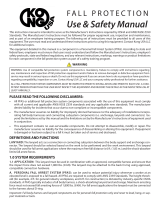 Kong Back-Up Shock Pack User manual
Kong Back-Up Shock Pack User manual
-
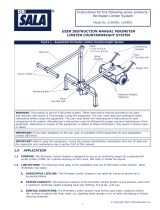 DBI/Sala Water Dispenser 2100090 User manual
DBI/Sala Water Dispenser 2100090 User manual
-
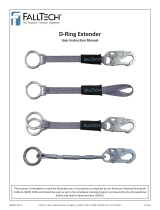 FallTech D-Ring Extender User Instruction Manual
FallTech D-Ring Extender User Instruction Manual
-
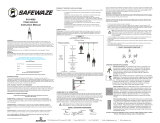 SafeWaze 018-4000 Owner's manual
SafeWaze 018-4000 Owner's manual
-
Miller 475 User manual
-
Klein Tools 87480 Operating instructions
-
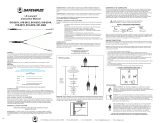 SafeWaze 019-2013 Owner's manual
SafeWaze 019-2013 Owner's manual
-
Gibraltar Mailboxes PALPP500W Installation guide
-
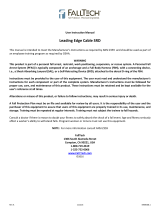 FallTech 727650LE User guide
FallTech 727650LE User guide
-
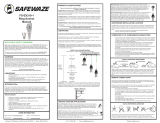 SafeWaze FS-EX310-1 Owner's manual
SafeWaze FS-EX310-1 Owner's manual


































